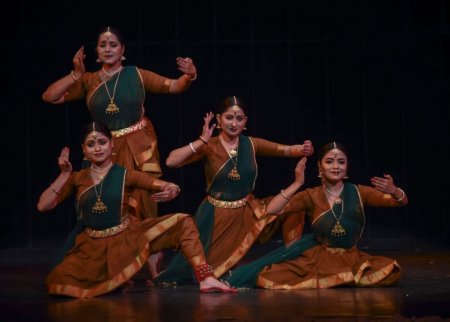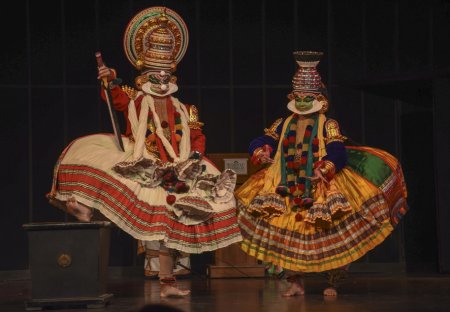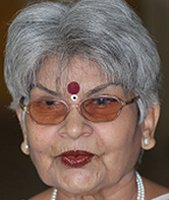
|   |

|   |
'Granthan: Classical Revelation' - Manjari Sinha e-mail: manjari@sinha.com Photos: Sanjit Debroy March 4, 2023 The Kolkata based Parampara in collaboration with Nadasutra, Delhi, recently presented 'Granthan-2023: Classical Revelation' at the Stein auditorium of the Habitat Centre, Delhi. The hall was buzzing with curiosity about the 'classical revelation' which categorically came out to be a musical evolution of beauty, spirituality, aesthetics, and harmony in 'Granthan', interweaving two different classical dance forms like Bharatanatyam and Kathakali, conjoining on a similar platform. The Bharatanatyam group of technically perfect and aesthetically draped dancers was trained under the well-known Bharatanatyam exponent Rajdeep Bannerjee, the Founder, Director, and Principal of Parampara, Kolkata. Working tirelessly to promote the rich cultural heritage, Rajdeep guided in the signature style of Kalakshetra by Prof C.V. Chandrashekar, has been teaching and organizing events, workshops, and training programs in and around the country including Bangladesh. 'Rajdeep is an altruistic and dynamic professional with proven abilities in managing the entire gamut of dance and music' was proven through his 'Ram-Katha' that gave 'Granthan-23', a flying start. His riveting 'Ram Katha' depicting the entire story of Ramayana through the idiom of Bharatanatyam, was based on the famous Carnatic Keertana "Piba re Rama rasam" written by Sadasiva Brahmendra in the Sanskrit language. This song is usually rendered in raga Ahir Bhairav of Hindustani classical music corresponding to the Carnatic ragam Chakravakam. Reminiscing the story of Ram through the portrayal of his journey from mortality to divinity, affirmed love, compassion, wisdom, and truth. The captivating choreography inspired by Tulsidas bhajan projected Shri Ram on a spiritual level with a contemporary approach, interweaving life, and its core values.   Parampara The dancers entered with the serene sound of the tuneful pair of taanpura providing a pious background to the allegiance of Aalapana in the auspicious ragam Nattai on violin and performed the invocatory ritual of Pooja-Archana followed by a crisp multi-dimensional Alarippu; before Rajdeep dressed as the saint poet/composer enters and sits down reverentially to write 'Rama-Rasam,' the Keertanam. Dancing to the rhythm of the song, the group of dancers formed dramatic vignettes of various episodes of Ram-Katha like the Sita Haran with a symbolic mask for Sita being dragged depicted through the flowing sari and Jatayu Vadham as a short dance-drama where Rajdeep enacted Ravan and Jatayu was depicted by a male dancer who is granted moksham by Ram, instantly the moment he dies. The essence of the Bhajan which translates as "Drinking the nectar i.e. reciting the name of Rama would help remove the sorrows of life and fear of death" was brought out effectively ending with a Bageshri Thillana, concluding with the tableau of the 'Rama-Durbar', where Rajdeep as the Dhanurdhaari Ram in the center was surrounded by all the devotees doing his Aarati with dhoop, deep, naivedya represented by the dancers Rittick Bhattacharya, Mousumi Sil, Bipasha Roy, Shreya Pramanick, Moumita Gupta and Sayan Sarkar.  Nadasutra The second half of the evening was presented in Kathakali by Nadasutra. An interesting excerpt from 'Duryodhana Vadham', this was conceived and choreographed as a two-act dance drama by Akash Mallick, the Founder and Director of Nadasutra Arts & Resonance, a cultural and performing arts center in Delhi. With a postgraduate degree in Performing Studies from Hyderabad Central University, Akash Mallick started learning Kathakali under Kalamandalam Piyal Bhattacharya in the Gurukul system and also achieved mastery over the lost sculpturesque dance style prescribed in Natyashastra, envisaged as 'Marga Natya' by his Guru after profound practical research and reconstruction. Akash has also studied the art of mizavu playing under Kalamandalam Eshwar Unni and basic Koodiyattam acting and vocal training under Kalamandalam Radhakrishnan. According to Akash, "Art is a unique medium to acquire self-knowledge and knowing about the world at large." The essential artistic, aesthetic and cultural components of art, he believes, help manifest an individual's creative potential at its best. And this was eloquently evident in his Kathakali presentation with live music this evening. With the conventional opening of the tirasheela (the colourful curtain), the story starts with Sri Krishna in Kaurava's court. Krishna pleads with Duryodhana and diplomatically tries to negotiate in favor of the Pandavas. Starting with half of the kingdom, Krishna comes down step by step to only five villages, five houses, and finally to one house. Duryodhana persistently refuses and finally in anger says he will not give even a pin-point space. After an exchange of fearful words, Duryodhana tries to bind Krishna with a rope. When he is about to be tied, Krishna uses his divine powers and shows his cosmic form, at which Duryodhana and other Kauravas become unconscious. Krishna departs and Duryodhana prepares for war. The peace mission having failed, the two sides, Pandavas and Kauravas, are on the battlefield. Arjuna, one of the Pandava brothers and a great warrior, is driven to the battlefield by Lord Krishna in his chariot. The chariot is stopped in-between the two mighty armies ready for the war. Arjuna surveys the enemy ranks and sees the great masters of archery, his Guru Dronacharya, his great grandfather Bhishma, and his other kith and kin arrayed against him. Arjuna asks Krishna what good it would bring him by winning a war after killing his own kith and kin. He wants the chariot to be turned back. The disheartened Arjuna is in no mood to fight and cannot even lift his bow. Lord Krishna chides Arjuna for his cowardice and tells him that his dharma as a Kshatriya is to fight for a righteous cause. Death and killing have to be understood in a proper perspective. The soul does not die; it only discards the body, just as new clothes are worn, discarding old ones. To infuse courage and self-confidence in Arjuna, Lord Krishna assures him with his Vishwaroopa (cosmic form) and appears before Arjuna as the Lord Supreme. Arjuna finds that his cosmic form has no beginning and no end. He realizes the truth in full measure. The enlightened Arjuna, charged with courage and conviction, is energized to fulfill his duty. The role of Duryodhana was played convincingly and with full vigour by Akash Mallick. Krishna by Ananya K Nair, Arjuna by Aishwarya CS, and Krishna in the second act was played by Vidhubala. The most authentic live music enhanced the alluring appeal of the whole performance, especially the tuneful vocal support by Kottakkal Jayan and Kalabharathi Radhakrishnan, who caught the attention of the rasikas from the very beginning when on the background of the finely tuned taanpura, Kottakkal Jayan reached the Mandra Saptak, the lower octave and the auspicious sound of conch heralded the tirasheela to be opened with the heroic atmosphere created by the percussions with the chenda by Kalamandalam Sumesh and maddalam by Sadanam Vijesh. The whole of the live orchestra created an appropriate effect to augment the desired rasa bhava for every scene. The chutti by Kalanilayam Nitheesh, Leena Sudheer, and the overall in-charge Kalamandalam Anil Kumar also need mention.  Manjari Sinha has an M.A. in Sanskrit and Music, and trained in vocal, tabla, sitar and Kathak dance. She has regular columns in national dailies as a music and dance critic. |